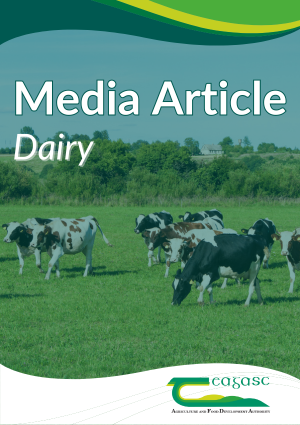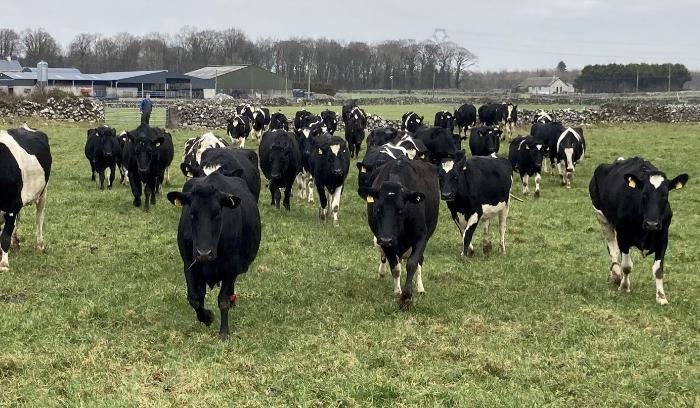
Profiting from Grass on the Dairy Farm this spring
Profiting from Grass on the Dairy Farm this spring 12 February 2025 Type Media Article By Tom Murphy, B&T Dairy Adviser, Teagasc, Galway/Clare Spring officially arrived at the start of February! The hum of the milking machine can again be heard on spring-calving dairy farms as the start of calving has given way to the […]
By By Tom Murphy, B&T Dairy Adviser, Teagasc, Galway/Clare

Profiting from Grass on the Dairy Farm this spring
Type Media Article
By Tom Murphy, B&T Dairy Adviser, Teagasc, Galway/Clare
Spring officially arrived at the start of February! The hum of the milking machine can again be heard on spring-calving dairy farms as the start of calving has given way to the dry cow vacation period. Workload is building, and will accelerate to reach its annual peak in the coming weeks, as the list of jobs-to-do grows mercilessly. Consequently, the risk of important management tasks getting rescheduled or shelved is very high at this time.
However, if your grassland management plans fall victim to the workload challenge, you will certainly pay a large price. Ultimately, your farm profit will be significantly reduced. Each extra days grazing in spring is worth in the region of €4 per cow per day.
Put simply, “Grazed Grass” is, and will continue to be the cheapest animal feed for milk production in Ireland. Teagasc identified a grazing season of 300+days as the main Key Performance Indicator in relation to grassland management. By getting cows out to grass in early February, with corresponding good management, you should achieve ten grazing rotations, and a grass utilised yield of 10t per ha dry matter for 2025.
Indeed, most Irish dairy farms, especially with spring calving herds, have conformed and consolidated in recent years with a keen drive to follow the proven blueprint. Overall, calving spread has tightened, and become closer matched to the start of the grass growing season, with most calves being born between 10th of February and the 1st of March. Recommended grass opening covers (1,000 kg DM/ha) are significantly higher than in previous years. The Teagasc Grass-10 team report an average opening farm cover (grass cover on 1st of Feb) of 862 kg DM/ha on Pasturebase Ireland (PBI) recording Dairy farms this spring.
In our experience, dairy farmers who systematically follow an autumn grazing closing plan to ensure the farm has a high opening grass cover, always successfully graze through these covers to plan, regardless of weather conditions. However, all dairy grazing blocks (even where grass covers aren’t close to target) benefit most when grazing starts in February. The proven benefit effects subsequent grass growth and quality, the cows health and production and the farmer’s workload and profitability. The three daily objectives of spring grazing are to
- Feed the cow (spring grass is a high dry matter, high energy forage)
- Minimise severe poaching
- Manage grazing to achieve residuals of 3.5cm
However, not all dairy farmers are maximising the potential benefit from spring grazing. Geographical location, weather and soil type are often mentioned by those who fear to push the boat out, and fail to get their cows to grass in February. Interestingly, recorded long-term average rainfall figures for February and March are quite similar in both our Ballyhaise (Co. Cavan) and Moorepark (Co. Cork) Dairy Research Centres. Whilst the “Rainy Days” will come, then on/off grazing and well planned (but flexible) grazing techniques can be called upon. However, many farmers have this well mastered, even on some very heavy or mixed soil type farms.
A simple tool that’s stood the test of time (and the test of adverse conditions) is the “Spring Rotation Planner”. If you are not already familiar with this, it’s a simple plan or guide to help you set and ensure you successfully reach your first rotation grazing target. Ideally, you should achieve a grazing target of:
- First third grazed by the end of Feb/first week of March
- Second third grazed by the 20th March
- Third (final) third grazed by the 5th to 10th April
Additional to this, if you are practicing grass measuring and budgeting, you can use the PBI online grass programme’s “Spring-Budgeting” planner to build in flexibility. Adjustments to the plan can be examined to match changing circumstances of grass supply and demand with addition or subtraction of meals and/or quality silage.
Ideally, first rotation grazing should begin from early February, starting with grass covers of 700kg DM/ha to 1,000kg DM/ha. Freshly calved cows should be let out to grass by day from four days post calving. The decision go night and day (two bouts of grazing), should be based on the target grazing plan and the grass supply available on the farm.
To maximise grass growth rate in spring, an initial application of 16 to 20 units per acre of nitrogen (preferably a protected Urea product) should be applied to trafficable paddocks. Where dilute slurry (2,000 gallons per acre) has already been applied, then the growth requirement has been met. Ensure you adhere to buffer zones, and rainfall warnings in advance of spreading.
The Teagasc KT and Grass_10 team are running 30 or more Spring Grazing events during February and March. Three of these are in Galway and Clare. These events will give more detail to the basics outlined above, and should help to answer the many questions and concerns of Dairy farmers who are keen to cash in on successful spring grazing.

Dairy Cows at grass by day from calving (since Feb 1st 2025) on Tim Kelly’s farm Clorane, Athenry.
